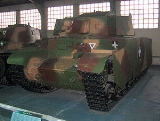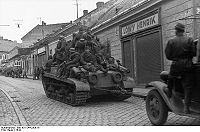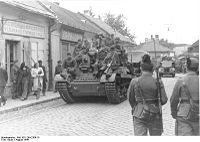
40 M Turan I
Encyclopedia
40M Turán I was a Hungarian
tank of World War II
- a total of 424 were made in two variants: Turan I with a 40 mm gun
and Turan II with a 75 mm gun. It was based on the design of the Czechoslovak
Škoda T-21 medium tank prototype.
workshops prepared a prototype of a medium tank based on the earlier successful LT vz. 35 project. Two prototypes were started and designated S-IIc, but their construction was never finished. The tank weighed 16.5 tonne, was armed with a 47 mm Škoda A9 vz. 38 gun, two 7.92 mm machine guns and its maximum armour was extended to 30 mm. Finally, the S-II-c was to have a better 13.8 liters engine giving 250 hp; this increased the maximum speed to roughly 50 km/h.
After Germany annexed Czechoslovakia, the prototypes were finished under the new designation of T-21, which in turn was a predecessor of a new prototype; the T-22. Two of the latter type were given to Hungary
in 1941. The Hungarian engineers further extended the front armour to 50 mm and replaced the 47 mm gun with a 40 mm Škoda A17. The overall weight was also increased to over 18 tonnes.

 The Turan was produced in several versions. The Turan I was the original medium tank type, which mounted the 40 mm gun. The gun, the standard Hungarian light anti-tank gun, could fire the same ammunition as the Bofors 40 mm anti-aircraft gun. The gun was mounted in a riveted turret. A total of 285 tanks were produced between 1941 and 1944.
The Turan was produced in several versions. The Turan I was the original medium tank type, which mounted the 40 mm gun. The gun, the standard Hungarian light anti-tank gun, could fire the same ammunition as the Bofors 40 mm anti-aircraft gun. The gun was mounted in a riveted turret. A total of 285 tanks were produced between 1941 and 1944.
After the disastrous Stalingrad offensive, the army realized that they needed a more powerful weapon to counter the more effective Soviet tanks, especially the T-34
. A variant was ordered which utilized a short 75 mm gun in an enlarged turret. Known as the 41M Turan II, this vehicle otherwise remained virtually unchanged from the original vehicle. Despite the improvement, the relatively low velocity of the projectile was unable to pierce the frontal armor of a T-34, except at point blank range. The T-34's main gun could penetrate the Turan's 50 mm of armor at a much greater distance. Hungarian manufacturers built a total of 139 vehicles in 1943 and 1944 before the Soviet occupation of Hungary.
Aside from tank production, the chassis was the basis for the Zrinyi II
assault gun. This mounted a 105 mm short gun in the hull, and lacked the traversable turret of a tank. Only 60 examples of this vehicle were produced. The only other vehicles known based on this chassis were the Turan III and the Zrinyi I, both of which used the German 75 mm L43 tank gun (which armed some variants of the German Panzer IV
medium tank). Both vehicles were produced as prototypes only, as the Hungarian Army were supplied with German armored vehicles.
Hungary
Hungary , officially the Republic of Hungary , is a landlocked country in Central Europe. It is situated in the Carpathian Basin and is bordered by Slovakia to the north, Ukraine and Romania to the east, Serbia and Croatia to the south, Slovenia to the southwest and Austria to the west. The...
tank of World War II
World War II
World War II, or the Second World War , was a global conflict lasting from 1939 to 1945, involving most of the world's nations—including all of the great powers—eventually forming two opposing military alliances: the Allies and the Axis...
- a total of 424 were made in two variants: Turan I with a 40 mm gun
Gun
A gun is a muzzle or breech-loaded projectile-firing weapon. There are various definitions depending on the nation and branch of service. A "gun" may be distinguished from other firearms in being a crew-served weapon such as a howitzer or mortar, as opposed to a small arm like a rifle or pistol,...
and Turan II with a 75 mm gun. It was based on the design of the Czechoslovak
Czechoslovakia
Czechoslovakia or Czecho-Slovakia was a sovereign state in Central Europe which existed from October 1918, when it declared its independence from the Austro-Hungarian Empire, until 1992...
Škoda T-21 medium tank prototype.
History
In December 1937 the ŠkodaŠkoda Works
Škoda Works was the largest industrial enterprise in Austro-Hungary and later in Czechoslovakia, one of its successor states. It was also one of the largest industrial conglomerates in Europe in the 20th century...
workshops prepared a prototype of a medium tank based on the earlier successful LT vz. 35 project. Two prototypes were started and designated S-IIc, but their construction was never finished. The tank weighed 16.5 tonne, was armed with a 47 mm Škoda A9 vz. 38 gun, two 7.92 mm machine guns and its maximum armour was extended to 30 mm. Finally, the S-II-c was to have a better 13.8 liters engine giving 250 hp; this increased the maximum speed to roughly 50 km/h.
After Germany annexed Czechoslovakia, the prototypes were finished under the new designation of T-21, which in turn was a predecessor of a new prototype; the T-22. Two of the latter type were given to Hungary
Hungary
Hungary , officially the Republic of Hungary , is a landlocked country in Central Europe. It is situated in the Carpathian Basin and is bordered by Slovakia to the north, Ukraine and Romania to the east, Serbia and Croatia to the south, Slovenia to the southwest and Austria to the west. The...
in 1941. The Hungarian engineers further extended the front armour to 50 mm and replaced the 47 mm gun with a 40 mm Škoda A17. The overall weight was also increased to over 18 tonnes.
Turan variants


After the disastrous Stalingrad offensive, the army realized that they needed a more powerful weapon to counter the more effective Soviet tanks, especially the T-34
T-34
The T-34 was a Soviet medium tank produced from 1940 to 1958. Although its armour and armament were surpassed by later tanks of the era, it has been often credited as the most effective, efficient and influential design of World War II...
. A variant was ordered which utilized a short 75 mm gun in an enlarged turret. Known as the 41M Turan II, this vehicle otherwise remained virtually unchanged from the original vehicle. Despite the improvement, the relatively low velocity of the projectile was unable to pierce the frontal armor of a T-34, except at point blank range. The T-34's main gun could penetrate the Turan's 50 mm of armor at a much greater distance. Hungarian manufacturers built a total of 139 vehicles in 1943 and 1944 before the Soviet occupation of Hungary.
Aside from tank production, the chassis was the basis for the Zrinyi II
43M Zrinyi II
Following the success of assault guns on the World War II Eastern Front, the Hungarians developed their own model, based on the chassis of the Turán tank. There were two designs, the 44M Zrínyi I, incorporated a long 43M 75mm gun, but it did not pass the prototype stage...
assault gun. This mounted a 105 mm short gun in the hull, and lacked the traversable turret of a tank. Only 60 examples of this vehicle were produced. The only other vehicles known based on this chassis were the Turan III and the Zrinyi I, both of which used the German 75 mm L43 tank gun (which armed some variants of the German Panzer IV
Panzer IV
The Panzerkampfwagen IV , commonly known as the Panzer IV, was a medium tank developed in Nazi Germany in the late 1930s and used extensively during the Second World War. Its ordnance inventory designation was Sd.Kfz...
medium tank). Both vehicles were produced as prototypes only, as the Hungarian Army were supplied with German armored vehicles.

